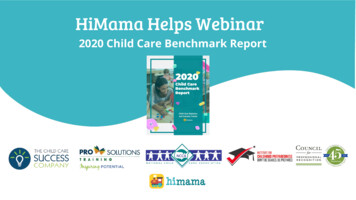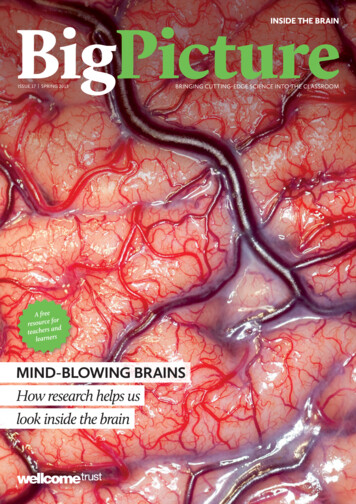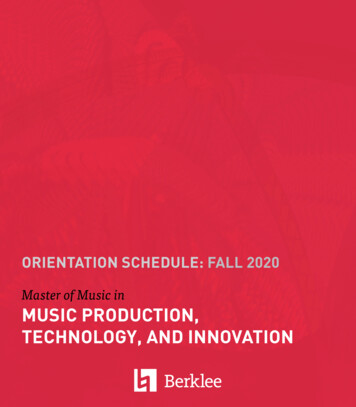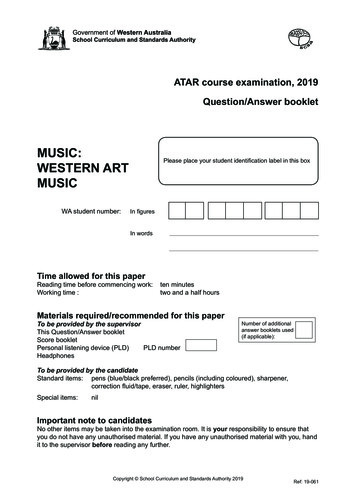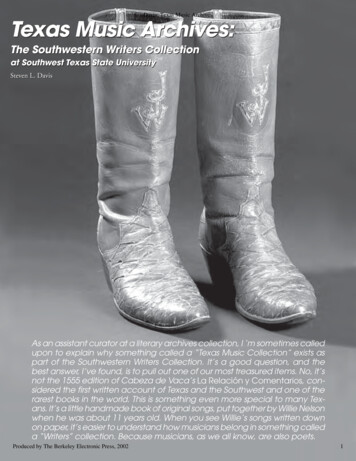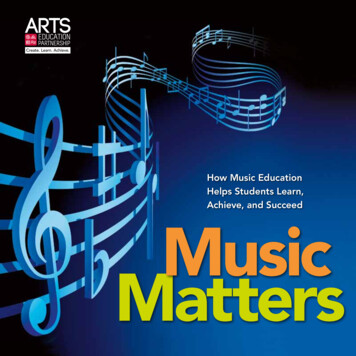
Transcription
How Music EducationHelps Students Learn,Achieve, and SucceedMusicMatters
MusicMattersHow Music Education HelpsStudents Learn, Achieve,and SucceedBeyond the intrinsic value of musicto cultures worldwide, education inBenefits of Music EducationAMusic education prepares students to learn1. Enhances fine motor skills2. Prepares the brain for achievement3. Fosters superior working memory4. Cultivates better thinking skillsBMusic education facilitates studentacademic achievement1. Improves recall and retention of verbal information2. Advances math achievement3. Boosts reading and English languagearts (ELA) skills4. Improves average SAT scoresCMusic education develops the creative capacities forlifelong success1. Sharpens student attentiveness2. Strengthens perseverance3. Equips students to be creative4. Supports better study habits and self-esteemmusic has benefits for young peoplethat transcend the musical domain. The ArtsEducation Partnership (AEP) reviewed anextensive body of research to identify highquality, evidence-based studies that documentstudent learning outcomes associated with aneducation in and through music. The resultsshow conclusively that music education equipsstudents with the foundational abilities to learn,to achieve in other core academic subjects, andto develop the capacities, skills and knowledgeessential for lifelong success.Music produces a kind of pleasure whichhuman nature cannot do without. Confucius
AMusic education prepares students to learn.Music education readies students for learning by helping to develop their basic mental skills andcapacities. Music instruction impacts learning in the following ways:1Enhances fine motor skills. Motor function is theability to use small, acute muscle movements towrite, use a computer, and perform other physicalactivities essential for classroom learning. The partsof the brain associated with sensory and motorfunction are developed through music instruction,and musically trained children have better motorfunction than non-musically trained children(Forgeard, 2008; Hyde, 2009; Schlaug et al., 2005).2Prepares the brain for achievement. Complexmath processes are more accessible to studentswho have studied music because the same parts ofthe brain used in processing math are strengthenedthrough practice in music. For example, studentswho take music in middle school score significantlyhigher on algebra assessments in ninth grade thantheir non-music counterparts, as theirbrains are already accustomedto performing the processesused in complex math(Helmrich, 2010).3Fosters superior working memory. Workingmemory is the ability to mentally hold, control andmanipulate information in order to complete higherorder tasks, such as reasoning and problem solving.Musicians are found to have superior workingmemory compared to non-musicians. Musicians arebetter able to sustain mental control during memoryand recall tasks, most likely as a result of their longterm musical training (Berti et al., 2006; Pallesen etal., 2010).4Cultivates better thinking skills. Thinking skills suchas abstract reasoning are integral to students’ abilityto apply knowledge and visualize solutions. Studieshave shown that young children whotake keyboard lessons have greaterabstract reasoning abilities thantheir peers, and these abilitiesimprove over time withsustained training in music(Rauscher, 2000).
BMusic education facilitates student academic achievement.Not only do students who study music develop musical abilities, they receive benefits that extendto other academic areas, leading to overall scholastic success. Music education benefits studentachievement in the following ways:1Improves recall and retention of verbal information.Musical training develops the region of the brainresponsible for verbal memory—the recall andretention of spoken words—which serves as afoundation for retaining information in all academicsubjects. Music students who were tested forverbal memory showed a superior recall for wordsas compared to non-music students (Ho et al.,1998; 2003).2Advances math achievement. Students whostudy music outperform their non-music peers inassessments of math, and the advantage that musicprovides increases over time. These findings hold trueregardless of socio-economic status and race/ethnicity(Baker, 2011; Catterall, 1998). Additionally, studentsinvolved in instrumental music do better in algebra, agateway for later achievement (Helmrich, 2010; U.S.National Mathematics Advisory Panel, 2008).3Boosts reading and English language arts(ELA) skills. Students who study music surpassnon-music students in assessments of writing, usinginformation resources, reading and responding, andproofreading. The gains in achievement of musicstudents compared to non-music students increaseover time (Baker, 2011; Catterall, 1998).4Increases average SAT scores. The SAT is astandardized test designed to measure “readinessfor college.” An analysis of 10 years of SAT datarevealed that students who took four years of artscourses in high school earned the highest scores onboth the verbal and math SAT, but overall, studentstaking any arts courses scored significantly higherthan students who took no arts courses (Vaughn etal., 2000). Of these students, those who took musiccourses earned the highest math and second highestverbal SAT scores (College Board, 2010).
CMusic education develops the creative capacities for lifelong success.Engagement, persistence, and creativity are components of higher-level thinking and complex problemsolving (Costa & Kallick, 2000). Music education nurtures these habits of mind that are essential forsuccess in today’s global, knowledge-based economy in the following ways:1Sharpens student attentiveness. The ability topay attention—visual focus, active listening andstaying on task—is essential to school performance.It begins to develop early in life and is continuouslyrefined. Early childhood training in instrumentalmusic improves these attention abilities, whilecontinued music education throughout adolescencereinforces and strengthens them (Neville et al.,2008). Attentiveness is an essential building block ofengagement, a competency necessary for success inschool and the workforce.3Equips students to be creative. Employers identifycreativity as one of the top five skills importantfor success in the workforce (Lichtenberg, Woock,& Wright, 2008). Music education helps developoriginality and flexibility, which are key componentsof creativity and innovation. Graduates frommusic programs report that creativity, teamwork,communication, and critical thinking are skills andcompetencies necessary in their work, regardless ofwhether they are working in music or in other fields(Craft, 2001; SNAAP, 2011).2Strengthens perseverance. Perseverance is theability to continue towards a goal when presentedwith obstacles. It is developed and strengthenedthrough music education. Students involved in musiclessons surpass their peers on tasks measuringperseverance. At the foundation of perseverance aremotivation, commitment and persistence, all traits ofcreative individuals (Scott, 1992).4Supports better study habits and self-esteem.A study of music majors found that they felt moreprepared for success in college than non-musicmajors. This readiness may be due to the musicmajors’ discipline and focus developed via intensepractice and performance routines prior to college.These habits are typical of music students and maygeneralize to other academic areas and social/emotional aspects of life, contributing to higher selfesteem and success (Chesky et al., 1997).Taken together, the studies in these three areas not onlyfortify one another but provide evidence of a continuum ofsuccess. Early and sustained educational experiences in musicdeliver multiple, reinforcing, and cumulative impacts that helpprepare young people to learn, achieve, and succeed.
AcknowledgementsThe Arts Education Partnership (AEP) acknowledgesthe generous support of the Quincy Jones MusiqConsortium and Madelyn Bonnot and Marty Albertsonfor the preparation of this brief. AEP also thanks MaryLuehrsen of The NAMM Foundation and Sue Rarus ofThe National Association for Music Education for theirassistance in the identification of research studies.About the ArtsEducation PartnershipThe Arts Education Partnership isdedicated to securing a high qualityarts education for every young person in America. Anational coalition of more than 100 education, arts,cultural, government, business and philanthropicorganizations, AEP was created in 1995 by the NationalEndowment for the Arts and the U.S. Department ofEducation and is administered by the Council of ChiefState School Officers and the National Assembly ofState Arts Agencies.Arts Education Partnership, Music Matters: How Music EducationHelps Students Learn, Achieve, and Succeed, Washington, D.C.,September 2011. One Massachusetts Ave., NWSuite 700Washington, DC 20001aep-arts.orgPrinting and distribution of this brochure made possible through agrant from the NAMM Foundation.CitationsBaker R. A. (2011). The Relationshipbetween Music and Visual Arts FormalStudy and Academic Achievement onthe Eighth-Grade Louisiana EducationalAssessment Program (LEAP) Test.(Doctoral dissertation, Louisiana StateUniversity, 2011).Berti, S., et al. (2006). DifferentInterference Effects in Musicians and aControl Group. Experimental Psychology,53(2), 111-116.Catterall, J. S., et al. (1998). Involvementin the Arts and Human Development:General Involvement and IntensiveInvolvement in Music and Theatre Arts. InE.B. Fiske (Ed.), Champions of Change (pp.1-18). Washington, DC: the Arts EducationPartnership & the President’s Committeeon the Arts and the Humanities.Chesky, K. S., & Hipple, J. (1997,December). Performance Anxiety,Alcohol-related Problems, and Social/Emotional Difficulties of College Students:A Comparative Study Between Lowerdivision Music and Non-music Majors.Medical Problems of Performing Artists,126-132.College Board. (2010). 2010 Collegebound Seniors Total Group Profile Report.New York.Costa, A. L., & Kallick, B. (2000).Describing the 16 Habits of Mind. Adaptedfrom A. L. Costa & B. Kallick, Habits ofMind: A Developmental Series. Alexandria,VA: Association for Supervision andCurriculum Development (ASCD).Craft, A. (2001). An Analysis of Researchand Literature on Creativity andEducation. Report Prepared for theQualifications and Curriculum Authority.Coventry, England.Forgeard, M., et al. (2008). Practicinga Musical Instrument in Childhood isAssociated with Enhanced Verbal Abilityand Nonverbal Reasoning. PLoS ONE3(10): e3566.Ho, Y., et al. (2003). Music TrainingImproves Verbal but Not VisualMemory: Cross-sectional andLongitudinal Explorations in Children.Neuropsychology, 17(3), 439-450.Hyde, K. L., et al. (2009). Musical TrainingShapes Structural Brain Development.The Journal of Neuroscience, 29(10),3019-3025.Lichtenberg, J., et al. (2008). Ready toInnovate: Are Educators and ExecutivesAligned on the Creative Readiness ofthe U.S. Workforce? New York, NY: TheConference Board.Gouzouasis, P., et al. (2007). The PredictiveRelationship Between Achievement andParticipation in Music and Achievementin Core Grade 12 Academic Subjects.Journal of Research in Music Education,9(1), 81-92.Neville, H., et al. (2008). Effects ofMusic Training on Brain and CognitiveDevelopment in Under-privileged 3- to5-year-old Children: Preliminary Results.In C. Asbury & B. Rich (Eds.), Learning,Arts, and the Brain: The Dana ConsortiumReport on Arts and Cognition (pp.105-116). New York, NY: Dana Press.Helmrich, B. H. (2010). Window ofOpportunity? Adolescence, Music, andAlgebra. Journal of Adolescent Research,25(4), 557-577.Pallesen, K. J., et al. (2010). CognitiveControl in Auditory Working Memory IsEnhanced in Musicians. PLoS ONE 5(6):e11120.Ho, Y., et al. (1998, November 12). MusicTraining Improves Verbal Memory. Nature,396, p 128.Rauscher, F. H., & Zupan M. A. (2000).Classroom Keyboard Instruction ImprovesKindergarten Children’s Spatial-TemporalPerformance: A Field Experiment. EarlyChildhood Research Quarterly 15(2),215-228.Schlaug, G., et al. (2005). Effects of MusicTraining on Children’s Brain and CognitiveDevelopment. In S.D. Lipscomb, et al(Eds.), Proceedings of the 8th InternationalConference on Music Perception &Cognition (pp. 133-134). Adelaide,Australia: Causal Productions.Scott, L. (1992). Attention andPerseverance Behaviors of PreschoolChildren Enrolled in Suzuki Violin Lessonsand Other Activities. Journal of Researchin Music Education, 40(3), 225-235.Strategic National Arts Alumni Project(SNAAP). (2010). Forks in the Road: TheMany Paths of Arts Alumni: StrategicNational Arts Alumni Project 2010Findings. Bloomington, IN.U.S. Department of Education. (2008).Foundations for Success: The Final Reportof the National Mathematics AdvisoryPanel. Washington, DC.Vaugh, K., & Winner, E. (2000). SAT Scoresof Students Who Study the Arts: WhatWe Can and Cannot Conclude aboutthe Association. Journal of AestheticEducation 34(3/4), 77-98.Wetter, O. E., et al. (2009). Does MusicalTraining Improve School Performance?Instructional Science, 37, 365-374.
Music education readies students for learning by helping to develop their basic mental skills and capacities. Music instruction impacts learning in the following ways: A 1 Enhances fine motor skills. Motor function is the ability to use small, acute muscle movements to write, use





